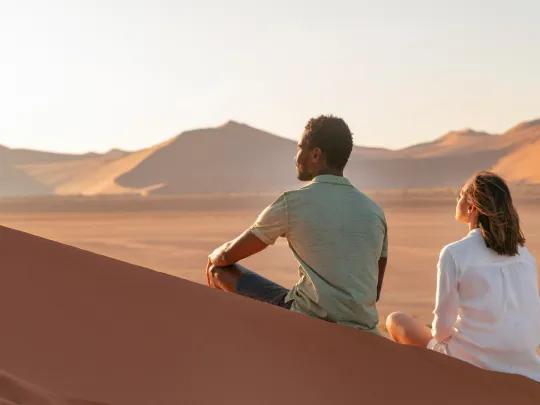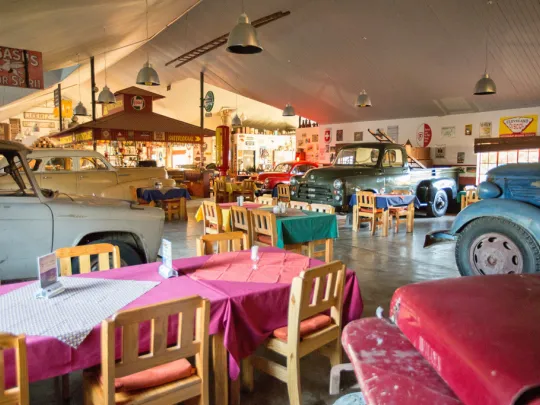Fish River Canyon Travel Guide
Fish River Canyon Travel Guide
The Fish River Canyon, in the Ai-Ais Richtersveld Transfrontier Park, is where Namibia's longest river makes its way through the biggest canyon in the southern hemisphere. One of Namibia's best-kept secrets, this immense natural wonder can still be admired in more or less crowd-free peace. So vast is the Fish River Canyon that one of Africa's most challenging and beautiful hiking trails takes an arduous five days to walk along a gruelling 86 km (54 miles) section of this 160 km (99 miles) long fissure.
Highlights
- Considered the second-largest canyon in the world and one of Africa's most impressive natural wonders
- Unforgettable, stark landscapes and breathtaking views
- Unique Nama and succulent Karoo desert ecosystems of the Ai-Ais Richtersveld Transfrontier Park
- Walking along the rim of the canyon and photographing this natural wonder
- Hiking in the canyon or fishing and swimming when water levels are high enough
- Profound sense of vastness and peace in a pristine place, free from human development
A sight too vast to appreciate with one look and too magnificent to be adequately captured on camera, the Fish River Canyon is a natural spectacle some 550 m deep, 27 km wide and 160 km long. This astounding canyon cuts through the Koubis massif in southern Namibia, from Seeheim to the confluence of the Fish and Gariep Rivers, the latter forming a natural border between Namibia and South Africa. Approaching the canyon from the open plateau to the north, the vertical drop into this fissure opens up dramatically and unexpectedly, presenting breathtaking views over rocky gorges and a lunar-like landscape.
Fish River Canyon attractions
- Spectacular views – from the main viewpoint near Hobas rest camp and from other spots along the rim
- The Ai-Ais Hot Springs – a soothing soak in the mineral springs, conveniently located at the end of the five-day hiking trail
- Desert Karoo – lunar-like scenery on the flat plateau and protected areas where a few creatures can be spotted
- Canon Roadhouse – an eccentric spot for a cold drink, affordable bite or interesting stopover in creative Route 66-style
- Hiking trails – short walks into, along, and around the canyon and the notorious hiking trail, best done during the cooler months
- Activities – scenic chartered flights, mule trekking, horse riding, nature drives and kayaking in season
Life in the Fish River Canyon
The canyon is mostly dry, with the Fish River flowing seasonally and shrinking to a few pools along the canyon floor for most of the year. However, during the rainy season from January to April the Fish River usually floods, turning into a turbulent fast-flowing waterway. Although the canyon is largely dry, there are pockets of green where more leafy plants, palms and trees grow in oasis-like patches. Generally, you will come across drought-resistant plants, like euphorbias, aloes and the occasional quiver tree.
Although it's not a game-viewing destination, you may be lucky enough to spot small klipspringer antelope and dassies (rock hyrax) darting over the rocks. Bigger mammals commonly sighted include baboons and in the Ai-Ais Richtersveld Park surrounding the canyon, kudu and Hartmann's mountain zebra. Leopards are found here but are very rarely seen. You are more likely to come across an assortment of reptiles in this harsh, arid habitat.
If you keep a keen eye out, you may spot several bird species including kestrel, heron, pigeon, hamerkop, kingfisher, plover and wagtail, as well as soaring black eagles. Near Ai-Ais, you may spot the Karoo eremomela, a small plain warbler, and on the plateau ostriches and bustards may be spotted, among other species.
As for humans, traces of inhabitance in the canyon date back to around 50,000 years ago. The days of the Fish River Canyon serving as an oasis for our Stone Age ancestors are, however, long gone. Today, tourists and hikers come and go with a scattering of people living near, but not in, the canyon.
The formation and history of Fish River Canyon
The stage was set for the Fish River Canyon about 1.8 billion years ago with the formation of a shallow sea that covered huge parts of southern Namibia. Over millennia, major changes began taking place in the landscape and tectonic shifts created an enormous valley stretching from north to south. After about 200 million years of steady erosion by the elements, the Dwyka Ice Age saw large glaciers that carved deeper into the earth, reshaping the valley. Hot springs, such as Ai-Ais, welled up from the fault lines in the Earth's crust, within the deep valley. About 50 million years ago, the Fish River began the task of shaping the inner walls and carving striking rock formations into the sides and floor of the canyon.
The Fish River travels some 650 km from the Eastern Naukluft Mountains down into the Ai-Ais National Park, which was established in 1969. In 2003, the larger Ai-Ais Richtersveld Transfrontier Park was established, joining the Ai-Ais Hot Springs Game Park with the Richtersveld National Park in South Africa. The Fish River Canyon now falls within this 5,920 square metre peace park, a surprisingly rich and biodiverse area, recognised as a UNESCO World Heritage Site.
Canyon conditions
In this extreme and rugged terrain, temperatures can be stark. Winter night temperatures can dip below 5°C (40°F) with midday temperatures soaring over 30°C. In the more humid summer months, sweltering daytime temperatures can climb to over 40°C (104°F). Despite its seasonal flow, the Fish River is still the only one of Namibia's rivers that retains some water in its deepest reaches during the heart of the dry winters.
Sunblock, a sun hat, sunglasses and loads of drinking water are must-haves when you visit here.
You may also want to look at

7 Day Namibia Fly-in Safari
This seven-day luxury fly-in safari explores some of Namibia's most iconic safari destinations – the distinctive ochre dunes of Sossusvlei, the rugged, desolate landscape of Damaraland and the Kaokoveld, where you're likely to spot the legendary desert-adapted elephant, and Etosha, Namibia's ancient national park. Flying over this vast country, you'll also get an insight into its fascinating details and incredible landscapes.

9 Day Best of Namibia Safari
Discover Namibia's most iconic landscapes and wildlife with a top nature guide on this expertly planned 9-day safari. From the towering red dunes of Sossusvlei and the wild Atlantic shores of Swakopmund to the rugged beauty of Damaraland and the wildlife-rich plains of Etosha National Park, this small-group tour offers a comprehensive introduction to Namibia. Prefer a private trip? We can tailor the itinerary to suit your interests.

Canyon Roadhouse
Quirky personality and a sense of bygone times give Canyon Roadhouse its special charm. The roadhouse-style lodge is located 25km from the impressive Fish River Canyon, arguably the second-largest canyon in the world. This unique spot is praised for its friendly staff and creative flair and it offers a fun, laid-back stay in remote southern Namibia. The 24 spacious, en-suite rooms are set around courtyards featuring the unusual flora of this arid region, and the main restaurant brims with vintage decor that adds to its old-world appeal.













